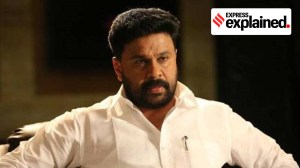Once upon a time in Ramgarh
What would happen if Gabbar Singh's children returned to Ramgarh to avengetheir father's death? This is one of the most likely scenarios b...

What would happen if Gabbar Singh’s children returned to Ramgarh to avengetheir father’s death? This is one of the most likely scenarios beingdiscussed as the take-off point for Sholay-II, the sequel to the film thathas perhaps meant more to us than any other movie. Ray’s classics werebetter acclaimed and Barjatya’s songathons made more money but it is onlySholay that 25 years on we can still rattle off: Arre O Sambha, kitnainaam rakhe hain sarkar hum pe? and conjure crystal clear images oflaconic Jai, goofy Veeru, Thakur, always on his dignity, Gabbar — like noother ever, motormouth Basanti, Soorma Bhopali, Jailer, and evenDharmendra’s mausijeeee’. Enduring icons to worshipful generations.
From Malti Sahai and Wimal Dissanayake’s Sholay: A Cultural Reading tointellectual critique in opaque, heavyweight film journals, there have beenattempts to deconstruct Sholay, and to unravel its mystique but there are nosimple answers. The statistics boggle: The film completed a run of 25 weeksin 90 centres across the country, a record that remains untouched; and inmovie-mad Bombay it ran for an unprecedented five years. Of which, the firstthree years were sold housefull in advance booking! The first two weeksafter Sholay was released, trade magazines tagged it an average commissionearner (translated from jargon it means a film which barely recovers itscost of production), prompting producer G.P. Sippy who was also then thepresident of the All India Film Producers’s Council to clamp a ban on TradeGuide and Film Information. He then helped start another publication todisseminate “accurate” collection figures.
But lesser known is the story, which Sippy now insists is apocryphal, of thedeal he cut with a Sindhi gentleman who shall remain unnamed when he thoughtthe film was indeed coming unstuck at the box office. Apparently, thegentleman, a financier, approached Sippy with an offer of Rs 11 lakh as downpayment in lieu of the collections of Sholay at Bombay’s Minerva theatre forthe first 25 weeks, if the film ran that long. The canny Sindhi, filmlorehas it, ran smirking all the way to the bank, as Sholay unspooled week afterweek to create box-office magic.
“Essentially, it is a simple, earthy story with a quality of folklore,”says Javed Akhtar who co-wrote the film with Salim Khan. “But thesimplicity and openness of the plot covered the complete spectrum ofemotion. The contrast of characters was centrifugal to the film. If SanjeevKumar’s Thakur was a crisp, clean dignified man then Amjad Khan’s Gabbar wasdirty, garrulous and vicious. If Dharmendra’s character was boisterous, thenAmitabh’s Jai was quiet and introvert,” he points out.
The first 70 mm film in India with magnified sound effects, Sholay explodedon the screen with a sledgehammer brilliance that left audiences stunnedacross the country. Whether it was the gruesome killing of Thakur’s family,the tragic death of Sachin, the bond between Jai and Veeru exemplified bythe coin that always fell with a stereophonic chchhannn’ on heads, thestunning sequence in which the Thakur’s shawl blows away after the Holimassacre or Gabbar’s chilling: Ab goli kha…’.
In an interview Ramesh Sippy, who later sensitively directed Shakti andBuniyad, but who could never reprise the brilliance of Sholay attributed thefilm’s magic to its unique characterisation that resonated Indianness.Dubbed by critics as a Sergio Leone-inspired curry western, Sholay’scharacters and situations were unarguably Hindustani.
Gabbar’s character is a prime example. In Nasreen Munni Kabir’s TalkingFilms, Javed Akhtar says that there is “some Mexican blood in Gabar. He’s abandit not a dakoo.” Aided no doubt by the fact that Gabbar was the firstdacoit in Hindi films to wear jeans. (“Prior to Sholay all dacoits woredhoti but as I wanted the film to do well abroad I thought a protagonistwearing jeans would go down well. Despite everyone’s argument that dakoosonly wear dhotis I prevailed saying, in bloody cinema anything canhappen’,” chortles G.P. Sippy).
Yet, Gabbar’s language is his — a version of North Indian khadi boli. JavedAkhtar says that Gabbar seemed to acquire life and vocabulary of his own ashe wrote the film. “His sadism lies in his choice of words like khurach,khurach (scratch) when he talks to Hema Malini, for instance,” says Akhtarin Talking Films. “Dekho chhamiya, zyada nakhre mat karo humse, nahin to yegori chamdi hai na-saare badan se khurach khurach ke utaar doonga”. Thereare others who go beyond the dialogue and attribute the film’s success toits unsaid nuances that give the audience their own space to imagine. Toparticipate in the story with their own sacrosanct images of what liesbehind the Thakur’s silence, Sachin’s death, Amitabh and Jaya’s wordlessromance to that final moment when Veeru and Basanti meet each other,somewhat awkwardly, on the train chugging out of Ramgarh.
And it is perhaps these unsaid moments that give the sequel-makers hope forSholay-II.
So, what would happen if Gabbar’s children returned to Ramgarh to avengetheir father’s death?
Do we really want to know?
- 01
- 02
- 03
- 04
- 05































